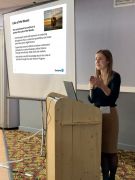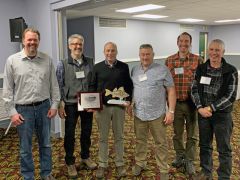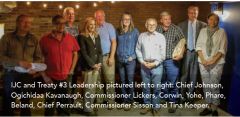- Details
 Andrea Khanjin, Parliamentary Assistant to the Ontario Minister of Environment, Conservation & Parks, Jeff Yurek, and MPP for Barrie – Innisfil delivered an address at the Rainy-Lake of the Woods Watershed Forum. She highlighted progress under Ontario’s Environment Plan which identified Lake of the Woods as a priority for actions and asserted the commitments of the Government of Ontario to Lake of the Woods
Andrea Khanjin, Parliamentary Assistant to the Ontario Minister of Environment, Conservation & Parks, Jeff Yurek, and MPP for Barrie – Innisfil delivered an address at the Rainy-Lake of the Woods Watershed Forum. She highlighted progress under Ontario’s Environment Plan which identified Lake of the Woods as a priority for actions and asserted the commitments of the Government of Ontario to Lake of the Woods
- Details
 Our annual International Rainy-Lake of the Woods Watershed Forum took place March 11-12 in International Falls, Minnesota. The Forum program featured an update on the Minnesota plan to cut phosphorus, a focus session on toxins produced by algae, a full day devoted to outcomes of Environment Canada’s Lake of the Woods science program and an international panel discussion session on next steps – with science as the foundation, how do Canadian and American agencies move forward to develop a plan for the lake.
Our annual International Rainy-Lake of the Woods Watershed Forum took place March 11-12 in International Falls, Minnesota. The Forum program featured an update on the Minnesota plan to cut phosphorus, a focus session on toxins produced by algae, a full day devoted to outcomes of Environment Canada’s Lake of the Woods science program and an international panel discussion session on next steps – with science as the foundation, how do Canadian and American agencies move forward to develop a plan for the lake.
- Details
 Tim Pascoe, Environmental Scientist with Environment and Climate Change Canada (ECCC) is the 2020 recipient of the Kallemeyn Award, recognizing his outstanding professional achievements and contributions to collaborative research and resource management in the Rainy-Lake of the Woods Basin.
Tim Pascoe, Environmental Scientist with Environment and Climate Change Canada (ECCC) is the 2020 recipient of the Kallemeyn Award, recognizing his outstanding professional achievements and contributions to collaborative research and resource management in the Rainy-Lake of the Woods Basin.
The Kallemeyn Award was presented to Tim by the Lake of the Woods Water Sustainability Foundation on behalf of the community of scientists and resource managers from the United States and Canada attending the 2020 International Rainy-Lake of the Woods Watershed Forum in International Falls, MN.
- Details
 The Foundation presented Pauline Gerrard, Deputy Director of the IISD – Experimental Lakes Area, with the 2020 Wilson Stewardship Award for her leadership in developing environmental education programs at the IISD-ELA and for building knowledge sharing between scientists, First Nations community members and the general public and helping to educate the scientists of tomorrow.
The Foundation presented Pauline Gerrard, Deputy Director of the IISD – Experimental Lakes Area, with the 2020 Wilson Stewardship Award for her leadership in developing environmental education programs at the IISD-ELA and for building knowledge sharing between scientists, First Nations community members and the general public and helping to educate the scientists of tomorrow.
The Foundation presents the Wilson Stewardship Award annually to recognize individuals, groups, or projects that are making significant contributions to environmental stewardship in the Rainy-Lake of the Woods watershed.
- Details

August 15, 2019 in Treaty 2 Territory, Leadership from the Anishinaabe Nation of Treaty #3 and technical support staff met with International Joint Commission (IJC) Commissioners and staff at Prairie Firehouse in Brandon, MB.
An account of this important meeting as well as details of the Treaty #3 Nibi (water) Declaration is available in the pdf August edition of Treaty 3 News(602 KB) .
- Details
- Details
A must see for all!
Lake of the Woods: A History by Water
Lake of the Woods: Eastern Shores
